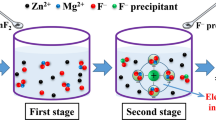Abstract
The presence of lead hydroxides in “pregnant cyanide solution” decreases the quality of the Dore obtained in the recovery processes of gold and silver, so it is convenient to remove them. The adsorbent capacity of the low cost cow bone powder was investigated for the removal of lead ions from a solution of lead hydroxide complexes at different initial metal ion concentrations (10 to 50 mg/L), and reaction time. Experiments were carried out in batches. The maximum sorption capacity of lead determined by the Langmuir model was found to be 126.58 mg/g, and the separation factor R L was between 0 and 1, indicating a significant affinity of bone for lead. Experimental data follow pseudo-second order kinetics suggesting chemisorption. It is concluded that cow bone powder can be successfully used for the removal of lead ions, and improves the quality of the silver–gold cyanides precipitate.







Similar content being viewed by others
References
F. Habashi: C.I.M. Bull., 1987, vol. 80, pp. 108–14.
K.B. Hall: World Min., 1974, vol. 27, pp. 44–9.
J.E. Hoffmann: Metall. Mater. Trans. B, 2012, vol. 43B, pp. 431–39.
J.R. Parga, J.L. Valenzuela, and F. Cepeda: J. Met., 2007, vol. 10, pp. 43–7.
I. Rehman, and W. Bonfield: J. Mater. Sci. Mater. Med., 1997, vol. 8, pp. 1–4.
S. Rayanaud, E. Champion, D. Bernache-Assollant, and P. Thomas: Characterization and thermal stability of powders Biomaterials, 2002, vol. 23, pp. 1065–72.
J.D. Miller, R.Y. Wan, and J.R. Parga: Hydrometallurgy, 1990, vol. 24, pp. 373–92.
V.S. Bagotsky: Fundamentals of Electrochemistry, 2nd ed., Wiley, Hoboken, NJ, 2006, p. 44.
G. Lapidus: Hydrometallurgy, 1995, vol. 39, pp. 251–63.
S. Jin, O. May, E. Ghali, and G. Deschenes: in Proceedings of Third International Conference on Hydrometallurgy, ICHM’98, Y. Xianwan, C. Qiyuan, and H. Aiping, eds., International Academic Publishers, Beijing, China, 1998, pp. 666–79.
L. Deng, Y. Su, H. Su, X. Wang, and X. Zhu: J. Hazard. Mater., 2007, vol. 143, pp. 220–25.
A. Gunay, E. Arslankaya, and I. Tosun: J. Hazard. Mater., 2007, vol. 146, pp. 362–71.
I.J. Alinnor: Fuel, 2007, vol. 86, pp. 853–57.
Q. Li, J. Zhai, W. Zhang, M. Wang, and J. Zhou: J. Hazard. Mater., 2007, vol. 141, pp. 163–67.
V.O. Njoku, A.A. Ayuk, E.E. Ejike, E.E. Oguzie, C.E. Duru, and O.S. Bello: Aust. J. Basic Appl. Sci., 2011, vol. 5, pp. 101–10.
E.A. Oluyemi, A.F. Adeyemi, and I.O. Olabanji: Res. J. Eng. Appl. Sci., 2012, vol. 1, pp. 308–13.
A. Sari, M. Tuzen, D. Citak, and M. Soylak: J. Hazard. Mater., 2007, vol. 148, pp. 387–94.
M. Rahbari, and A.S. Goharrizi: Water Environ Res., 2009, vol. 81, pp. 598–607.
Y.H. Li, S. Wang, J. Wei, X. Zhang, C. Xu, Z. Luan, D. Wu, and B. Wei: Chem. Phys. Lett., 2002, vol. 357, pp. 263–66.
A.G. Leyva, J. Marrero, P. Smichwoski, and D. Cicerone: J. Environ. Sci. Technol., 2001, vol. 35, pp. 3669–75.
Z.H. Cheng, A. Yasukawa, K. Kandori, and T. Ishikawa: Langmuir, 1998, vol. 14, pp. 6681–86.
D.S. Soejoko, and M.O. Tija: J. Mater. Sci., 2003, vol. 38, pp. 2087–93.
N.A.M. Barakat, K.A. Khalil, F.A. Sheikh, A.M. Omran, B. Gaihre, S.M. Khil, and H.Y. Kim: Mater. Sci. Eng., 2008, vol. C 28, pp. 1381–87.
K.R. Hall, L.C. Eagleton, A. Acrivos, and T. Vermeulen: Ind. Eng. Chem. Fundam., 1966, vol. 5, pp. 212–23.
R.F.P.M. Moreira, M.G. Peruch, and N.C. Kuhnen: Braz. J. Chem. Eng., 1998, vol. 15. doi:10.1590/S0104-66321997000300009.
M. Machida, R. Yamazaki, M. Aikawa, and H. Tatsumoto: Sep. Purif. Technol., 2005, vol. 46, pp. 88–94.
U. Ulusoy, and S. Simsek: J. Hazard. Mater., 2005, vol. 127, pp. 163–71.
Y. Bulut, and Z. Baysal: J. Environ. Manage., 2005, vol. 78, pp. 107–13.
M. Mouflih, A. Aklil, and S. Sebti: J. Hazard. Mater., 2005, vol. 119, pp. 183–88.
S.H. Jang, B.G. Min, Y.G. Jeong, W.S. Lyoo, and S.C. Lee: J. Hazard. Mater., 2008, vol. 152, pp. 1285–92.
S. Lagergren: Handlingar., 1898, vol. 24, pp. 1–34.
Y.S. Ho, and G. McKay: Process Biochem., 1999, vol. 34, pp. 451–65.
L. Martha, H. Figueroa, and B. Limon: Engineerings, 2008, vol. 41, pp. 24–31.
Z. Z. Chowdhury, S.M. Zain, and A.K. Rashid: E-J. Chem., 2011, vol. 8, pp. 333–39.
K. Chojnacka, and I. Michalak: Glob. NEST J., 2009, vol. 11, pp. 205–17.
J. Cha, M. Cui, M. Jang, S.H. Cho, D.H. Moon, and J. Khim: Environ. Geochem. Health, 2011, vol. 33, pp. 81–9.
D.H. Moon, K.H. Cheong, J. Khim, M. Wazne, S. Hyun, J.-H. Park, Y.-Y. Chang, and Y.S. Ok: Chemosphere, 2013, vol. 91, pp. 1349–54.
S. Saxena, M. Prasad, and S.F.D′ Souza: Ind. Eng. Chem. Res., 2006, vol. 45, pp. 9122–28.
P.K. Chaturvedi, C.S. Seth, and V. Misra: Chemosphere, 2006, vol. 64, pp. 1109–14.
K. Chojnacka: Chemosphere, 2004, vol. 59, pp. 315–20.
N.J. Coleman, D.S. Brassington, A. Raza, and A.P. Mendham: Waste Manage., 2006, vol. 26, pp. 260–67.
Acknowledgments
The authors wish to acknowledge support of this project to Minera William in Mexico, the National Council of Science and Technology (CONACYT), Directorate General of Higher Education Technology (DEGEST) of Mexico, and Lamar University Materials Instrumental Center.
Author information
Authors and Affiliations
Corresponding author
Additional information
Manuscript submitted January 31, 2013.
Rights and permissions
About this article
Cite this article
Parga, J.R., Martinez, R.F., Moreno, H. et al. Removal of Lead Hydroxides Complexes from Solutions Formed in Silver/Gold: Cyanidation Process. Metall Mater Trans B 45, 743–751 (2014). https://doi.org/10.1007/s11663-013-9962-1
Published:
Issue Date:
DOI: https://doi.org/10.1007/s11663-013-9962-1




